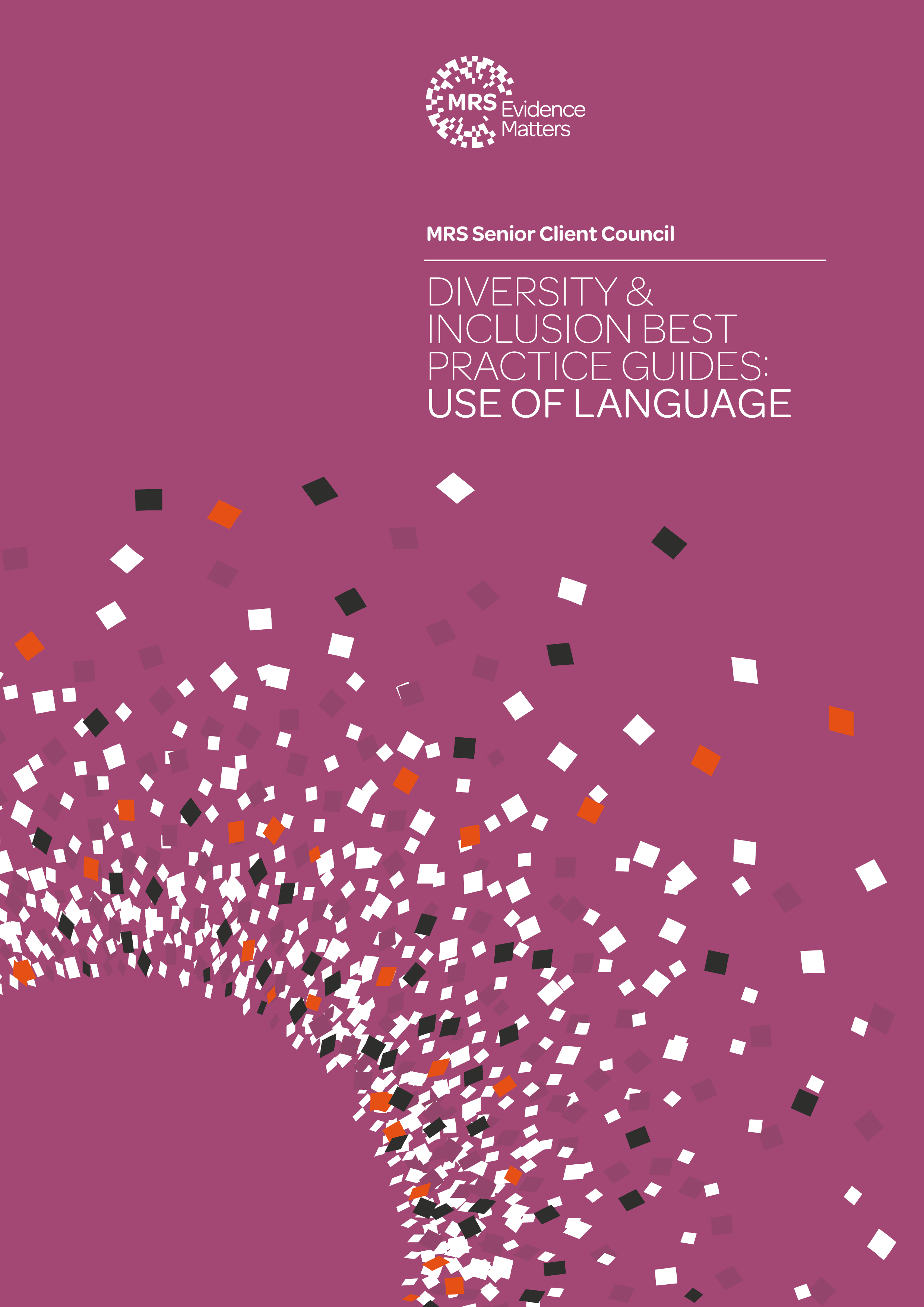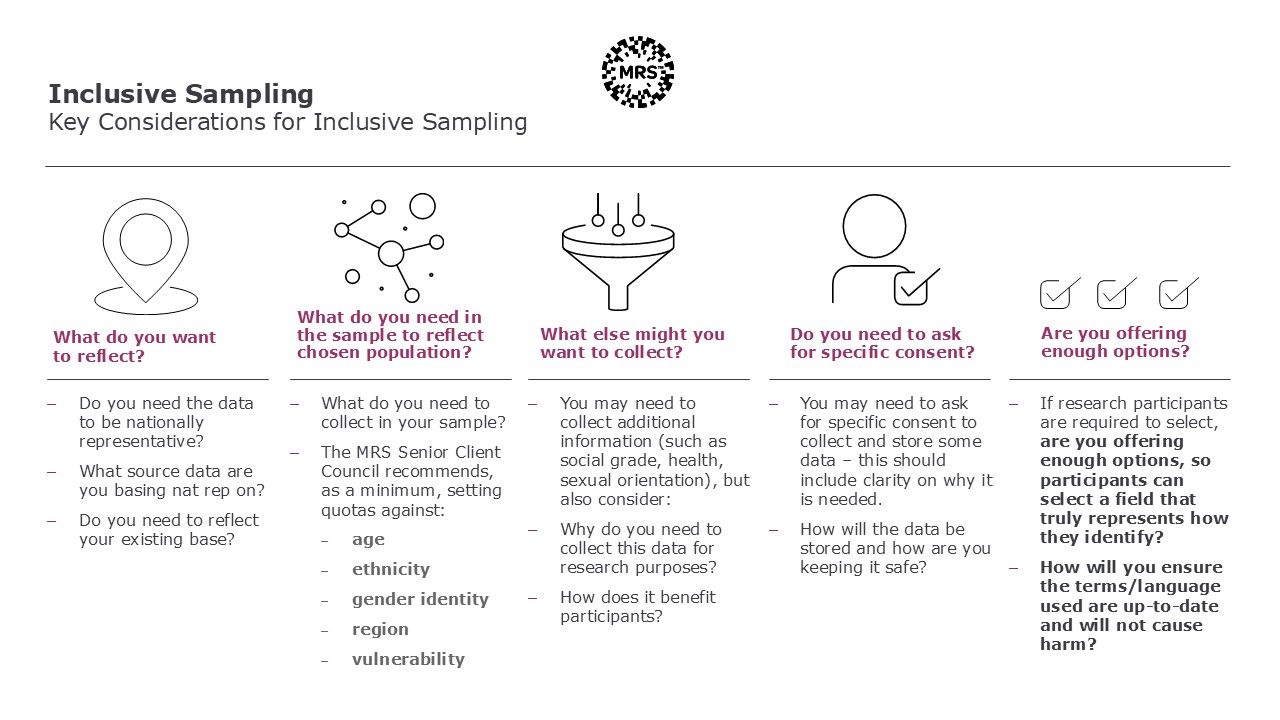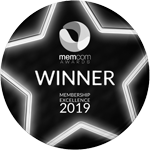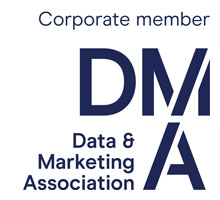Diversity and Inclusion Best Practice Guides and FAQs
This page includes guidance and best practice for clients and agencies.
- MRS Guidance – Essential Safeguards Series Part 7: Neurodiversity
- Commercial Benefits Study 2022 of nationally representative sampling – presentation of the results
- Is Your Research Really Representative – essential questions for understanding and undertaking inclusive research
- Ethnic & Racial Representation in Research & Data - How far did we come in 2021?
- MRS D&I in Samples
- MRS Best Practice Guide on Collecting Sample Data on Sexual Orientation
- MRS Best Practice Guide on Collecting Data on Sex And Gender
- MRS Best Practice Guide on Collecting Sample Data on Physical disabilities and/or mental health conditions
- MRS Best Practice Guide on Collecting Ethnicity Sample Data
Guidance on International Representation in Research
As part of the ongoing work of the MRS Representation in Research Steering Group, we have created a set of guidelines when working internationally to help ensure an inclusive, representative, engaging and safe approach to global research.
It is not practical for MRS to provide detailed and precise guidelines by country. Rather, we have identified three core areas to help practitioners address and navigate the international representation issues that need to be considered. These MRS guidelines are intended to help with developing a well-considered brief for conducting international research in any market. Local research organisations or other associations may have further guidance.
Representation in Research FAQs
The MRS Representation in Research group has been talking to research practitioners across the UK about the issue of participant representation in UK research projects. More specifically, how we can improve representation of groups that are often underrepresented. Over the course of this process, we have developed the following FAQs.
>> Read the Representation in Research FAQs
MRS Senior Client Council diversity & inclusion best practice guides: Inclusion is everyone’s responsibility
Representation in research is about more than just quotas, it’s also about ensuring participants have the opportunity to respond in a way they are comfortable – at all stages of the project.
Clare Woodward, Enterprise Insight Manager, BT & Nicole Smyth, Customer Insight, Holland & Barrett share the updated MRS Senior Client Council diversity & inclusion best practice guidelines on how to approach research moving forward in order to ensure inclusivity. They outline recommendations on inclusive sampling, inclusive language and inclusive methodologies and also discuss how clients and agencies should work together.
Nicole Smyth from Holland & Barrett and Clare Woodward from BT talk to Mark Thorpe about the MRS Senior Client Council diversity & inclusion best practice guidelines
Nicole Smyth, Customer Insight, Holland & Barrett
Nicole Smyth is an experienced Insight leader, having worked client-side within a number of UK and Global retailers, including ASDA, George Clothing and Debenhams, and most recently leading Strategic Insights at Holland & Barrett. With a passion for ensuring research is inclusive and representative, Nicole is involved with a number of EDI initiatives, including recently working alongside Clare Woodward (BT) to update the MRS client-side EDI Best Practice guides. Alongside this, Nicole is also leading EDI initiatives within Holland & Barrett to create insight team and agency guidelines focussed on improving representation in all areas of research and analysis.
Clare Woodward, Enterprise Insight Manager, BT
Clare Woodward is an experienced clientside research currently working for BT across B2B and B2C research projects. With a focus on ensuring research and the research industry are inclusive across both practices and culture, Clare is the original author of the MRS Clientside EDI Best Practice guides first published in May 2022 (and believed to the first of their kind!). Working alongside Nicole Smyth (Holland and Barrett) the guides have recently be reviewed and updated and will be relaunched following the MRS Clientside Conference. Clare is also a part of the MRS People and Talent workgroup and chairs the New and Returning Talent subgroup.
Sampling Methods
This ‘Sampling Methods’ document aims to provide the approach clients should take in regards to more inclusive sampling and data collection and has been prepared by members of the MRS Senior Client Council and client colleagues.
The sample should be as representative of quotas above as possible, unless research is targeted for a reason (e.g. specific focus on one gender).
The sample size should not be an excuse for not having a representative sample
- What is it you are trying to research?
- Think about all potential groups within the quota
- Considering intersectionality may help here
- It is important to remember that people are not homogenous – don’t assume that one person represents an entire group
Considerations
- What is currently done?
- Is this a piece of continuous research, or a new project?
- What is the impact of making changes (reporting/analysis) if continuous?
- Do you need the data to be nationally representative (nat rep)?
- What source are you using to base your population on (ONS/Census etc.) – is it the most up-to-date source?
- Do you need to reflect/represent your existing base?
- What type of research is it?
- Qualitative vs. quantitative – sample size may impact ability to quota
The latest guidelines recommend an extended version of Nat Rep, including; age, gender identity, region, social grade, ethnicity, sexual orientation, physical disability and/or mental health conditions
>> Download the Sampling Methods guide.
Use of Different Methods
This ‘Use of Different Methods’ document outlines the pros/cons of virtual vs. F2F, aiming to cover how our methods can consider more inclusive sampling and remain accessible. This guidance has been prepared by members of the MRS Senior Client Council and client colleagues.
Representation is about more than just quotas, it’s also about ensuring participants have the opportunity to respond – all stages of the project (from design to participant facing documents) need to consider this.
When designing your research project, consider the pros/cons of different methods in relation to the sample you are trying to reach – might certain methodologies create unintended blockers (e.g. in person focus groups with no disabled access to the room). Consider the individuals within your target sample and make allowances as necessary..
>> Download the Use of Different Methods guide.
Use of Language


This ‘Use of Language’ document examines what not to say/terms to avoid and has been prepared by members of the MRS Senior Client Council and client colleagues.
It’s important to ensure that all people are referred to, and given the option to declare themselves as, using language and terminology that they are comfortable with. The ‘correct’ terminology is personal, so it is always a good idea to find out how people prefer to describe themselves and use those terms, rather than making assumptions.
Language preferences and our understanding of the impact of certain words changes – ensure you are using the most up-to-date recommendations.
>> Download the Use of Language guidelines.
Working with Research Agencies and Suppliers to Ensure Inclusive Samples

This ‘Working with Research Agencies and Suppliers to Ensure Inclusive Samples’ guidance provides a client perspective on inclusion and has been prepared by members of the MRS Senior Client Council and client colleagues.
The MRS Code of Conduct requires transparent information about which sampling characteristics and parameters have been used when defining samples as representative of segments of the population, such as when reporting Nationally Representative samples.
Accessibility by Design Guidance for Clients

This Accessibility by Design Guidance for Clients provides a client perspective on inclusion and has been prepared by members of the MRS Senior Client Council and client colleagues.
Representation is about more than just quotas; it’s about ensuring participants can respond. An important step in preparing for research is understanding who is in the sample and their needs and requirements for reasonable adjustments. As clients look to make samples more diverse and inclusive, clients need to consider issues around accessibility.
ALL methodologies come with compromises: clearly recognise the limitations, and declare them as part of the research process.
Good design principles are applicable to everyone and not just those with access needs, and clients should be building accessibility into the design of research rather than retrofitting after build is complete.
>> Download a copy the Accessibility by Design for Clients guide
Get the latest MRS news
Our newsletters cover the latest MRS events, policy updates and research news.
















